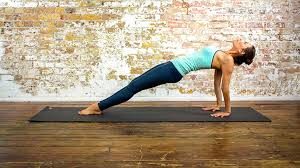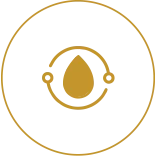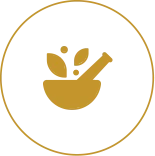Finally, there is an answer to those painful breathless bouts where you feel like you are being strangled. The answer lies in Yoga. The ancient science of Yoga not just helps you stay fit and flexible; it has immense healing qualities too, as many practitioners who lived with the pain and discomfort of chronic Asthma earlier will tell you.
According to medical experts, emotional trauma or stress can trigger asthmatic attacks. Yoga in this regard helps to reduce stress considerably. Powerful breathing exercises or Pranayamas that make an integral part of classical Yoga help in increasing the lung capacity, which also aids the fight against Asthma.
Pranayama in Sankrit is a conjunction of two beautiful words- Prana or Life force and Ayama or Dimension or control. Pranayama is that practice which involves controlled breathing that helps to increase the Prana of life force in the body. Higher the Prana in the body, there is more enthusiasm and positivity that one experiences throughout the day. Yoga and Pranayamas are not just a physical exercise but they are a union between the body, mind and spirit.
Here we share some Yogasanas or poses and breathing techniques that can help you deal with Asthma with sustained practice.
1.Pranayama
A) Alternate Nostril Breathing (Nadi Shodhan Pranayama)

Alternate nostril breathing channelizes the life force in different plexus or energy channels of our body. It not only awakens our body but our nervous system as well.
- Sit comfortably and bring your attention to your breath. Breath naturally for a few minutes.
- Gently bring your index finger closer to your thumb and extend rest fingers as straight as possible (as shown in the image).
- Begin by inhaling through both the nostrils and then exhaling out of one nostril. To do this, close off one of the nostrils using either the thumb or the ring finger.
- Breathe in from the same nostril you just exhaled from and switch nostrils using either the thumb or the ring finger and exhale from the opposite nostril. Again breathe in through the same nostril and switch before exhaling out the other nostril. This makes one round of Nadi Shodhan Pranayam.
- Practice 5-7 rounds to begin with and gradually as you practice regularly, you can increase the number of rounds.
- Finish by breathing out from the opposite nostril than the one you first exhaled from.
B) Yogic Breath

Yogic breath is done to expand the lung capacity and make the process of deep breathing smoother and deeper. For Yogic Breath,
- Sit in Sukhasana or easy pose.
- Place your right hand on your stomach and left hand on the chest.
- Sit straight, spine should be erect, chin up and then slowly take a long deep breath in, expand your chest, bloat your stomach,
- and slowly breathing out, relax your stomach, and relax your chest.
- Once again, take a long deep breath in, expand your chest, expand your stomach, and then slowly breathe out, relax your stomach and relax your chest.
- Repeat this cycle 5 times.
2. Yoga Poses
1) Wind-Relieving Pose (Pawanmuktasana)
As you are lying on your back, breathing in, bend your knees.
- Hold them with your hands.
- Interlace your fingers around folded knees and
- as you breathe out lift your head up.
- Try to touch your knees to the chest and nose.
- Stay there for 3-4 deep breaths.
- Relax your head back and slowly relax your fingers and knees in that order.
2) Seated Half Spinal Twist (Ardha Matsyendrasana)
For this asana,
- Bend the right knee,
- place the right foot next to the left hip,
- bend the left knee,
- place the left foot next to the right side of the right thigh,
- the left hand is on the right knee and the right hand behind you.
- Now, twist the waist, shoulders and neck in that order to the right and look over the right shoulder.
- Take a few deep breaths and feel the twist. Come back to the center and switch sides.
3) Cobra Pose (Bhujangasana)
Slowly lie down on the stomach. In Bhujangasana, take the mind towards the chest region.
- Both the hands and both the palms by the side of the shoulders.
- Slowly as you breathe in, lift your head up and chest up.
- Once your head and chest are lifted up, the stomach and rest of the body should be on the floor.
- Your ankles are on the floor and your elbows are close to your waist.
4) Upward Facing Dog (Urdhvamukha Shvanasana) And Downward Facing Dog (Adhomukha Shvanasana)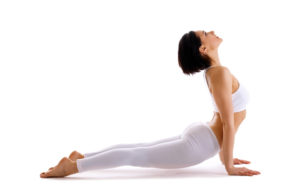
- Come into plank position or Dandasana. Here, both the palms on the floor aligned with both the shoulders, both the toes on the floor. So your whole body is in a single line.
- From your heels to the shoulders, it should look like a single alignment, approximately 30 degrees from the floor and
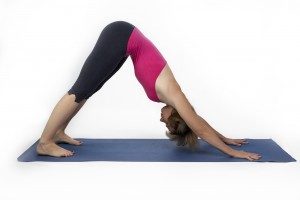
- your eye gaze is on the mat on the floor and your palms are in line with your shoulders.
- When you breathe in and breathe out, bend your elbows, drop your body down and then
- slowly as you breathe out, stretch your body slightly forward and lift up your body completely on your palms and on your ankles and look up. So your body makes a curve from the toes to top of your head, into an upward facing dog and then
- slowly as you breathe out, slowly come down, the upper body goes down and then lift your hips up, lift your whole body on your palms and on your heels. Come into the downward facing dog position.
- Once again as you breathe in, go in upward facing dog and then as you breathe out, downward facing dog.
- When you exhale, squeeze your stomach in, take you mind towards the abdomen region and then go in downward facing dog. Repeat this cycle 5 times. Finally relax in child pose.
5) Bridge Pose (Setu Bandhasana)
For Bridge pose, bend both your knees and place the feet on the floor, very close to your hips.
- Catch your ankles by the sides of your body and then
- slowly as you breathe in, lift your stomach up, lift your hips up.
- Your neck is resting on the floor and your head is resting on the floor.
- Stay in this posture for 5-7 long deep breaths.
- Slowly as you breathe out, relax your hips down and relax your entire back and bring it down and then slowly stretch out both the legs.
6) Butterfly Pose (Badhakonasana)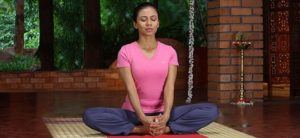
Sit in Sukhasana with legs crossed comfortably. Now for Butterfly pose,
- Make a Namaste with both the feet and come in butterfly pose. Once in this pose,
- Swing the knees like a butterfly. Take 2 deep breaths.
- As we breathe in, catch the toes, look up and slowly bend forward.
- Stay in this posture for 2-3 deep breaths.
- Slowly come up and relax.
7) Upward Plank Pose (Purvottanasana)
Lie on your back.
- For Purvottanasana, as you breathe in, lift your body up on your palms then on the toes.
- And slowly as you breathe out, come down and as you breathe in, hands by the side. Repeat this cycle 5 times.
8) Yoga Nidra
Having felt the stretch in all other parts of the body, now it is time to rest and let the body cells relax. It is very important that after doing asanas, we either finish the session with a soothing guided meditation of Yoga Nidra (Yogic sleep). Without proper rest after the asanas, you miss out on the most important experience of Yoga which is a deep spiritual rest that your body gets, after having exhausted the Rajas Guna in the body through focused activity.
Disclaimer: This article is only for informative purposes. It is strongly recommended for children and adults to learn and practice these asanas under the guidance and supervision of a trained and certified Sri Sri Yoga faculty.
Image credits-
Upward facing dog- www.doyouyoga.com
Bridge pose- www.yoga.com
Upward plank www.yoga.com
Butterfly pose- www.artofliving.org
Cobra pose- www.artofliving.org
Seated half spinal twist- www.artofliving.org
Wind-relieving pose- www.artofliving.org
Alternate nostril breathing- www.artofliving.org



